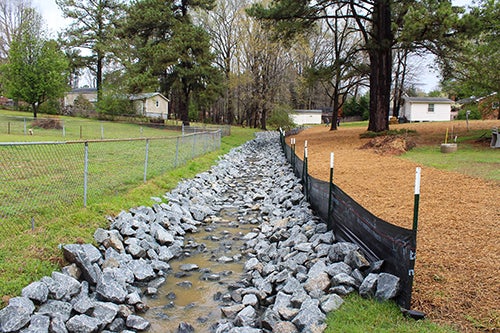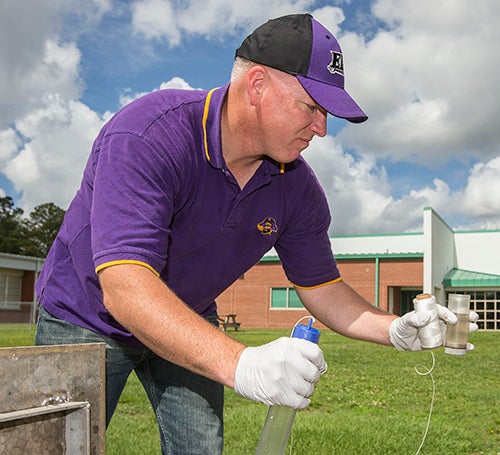BETTER WATER
Grant-funded ECU project aids Raleigh area watershed
An East Carolina University faculty member and graduate students are completing work on a three-year, grant-funded project to improve water quality in a Triangle-area watershed.
The project aims to boost the water quality in the Lick Creek watershed near Durham by improving the nutrient treatment efficiency of septic systems in the area, said Dr. Charlie Humphrey, associate professor of environmental health sciences and interim director of the Coastal Water Resources Center.
Included on a list of impaired streams, Lick Creek drains to Falls Lake, a nutrient-sensitive body of water and recreational area that serves as a major water supply for the Raleigh area. Previous reports indicated that improperly functioning septic systems were a likely source of nutrients to Lick Creek and Falls Lake, Humphrey said.
“We hope to reduce the nutrients that are delivered to Lick Creek and Falls Lake by improving the treatment efficiency of septic systems in the area,” Humphrey said.
During the spring semester, Humphrey worked with ECU coastal resources management doctoral student Guy Iverson and master of environmental health student Christa Sanderford to install a drainage way bioreactor in a small tributary of Lick Creek.

Work began earlier this year on the bioreactor project in a small tributary of Lick Creek. (Contributed Photo)
The bioreactor was installed to reduce nutrient, sediment and bacteria transport from a neighborhood with a high density of septic systems, Humphrey said.
The installation included excavating 2 to 3 feet of stream bed material, widening and stabilizing the banks of the drainage way, replacing the bed material with a 1.5-foot-layer of wood chips, 6 inches of engineered media that adsorbs pollutants, and large stone. The reactor is more than 200 feet long.
Last fall, Humphrey and the students also oversaw repair work to septic systems in the watershed including the replacement of a septic tank, drain field and broken effluent pipe. More than 35 septic tanks have been pumped during the project.
“The septic system and bioreactor work should reduce pollutant transport to Lick Creek,” Humphrey said.
ECU faculty and students will continue to monitor water quality over the next several months.

Dr. Charlie Humphrey (Photo by Cliff Hollis)
The project – which began in 2015 and is set to end next June – was funded through a $162,000 grant from the N.C. Department of Environmental Quality. A second grant for $143,050 was recently approved by the same state agency to continue efforts to improve water quality in Lick Creek. That work will get underway in early 2018, Humphrey said.
Several people have contributed to the project, he said. Recent ECU environmental health graduates Jordan Jernigan and Brent Serozi helped during the first year. ECU faculty and staff collaborators in the College of Health and Human Performance have included Dr. Tim Kelley, Dr. Stephanie Richards and Avian White, while Dr. Mike O’Driscoll in the Department of Geological Sciences and Caitlin Skibiel in the Coastal Water Resources Center also provided guidance and assistance.
Other partners included Dr. Eban Bean of the University of Florida (and formerly of ECU), Dr. Sushama Pradhan of the N.C. Department of Health and Human Services, Patrick Eaton of the Durham County Department of Public Health and Dr. Manoj Jha of N.C. A&T State University.
ECU offers one of only nine masters of environmental health programs in the United States accredited by the National Environmental Health Sciences Protection and Accreditation Council (NEHSPAC). ECU also offers the only NEHSPAC-accredited, totally online applied option degree in North Carolina. Enrollment in that program is limited to students with significant education or experience in environmental health or a related discipline.
For more information, visit http://www.ecu.edu/cs-hhp/hlth/EHST/graduatecurriculum.cfm.

East Carolina University faculty members and graduate students have been working on a grant-funded project to improve water quality in a Triangle-area watershed. (Contributed Photo)